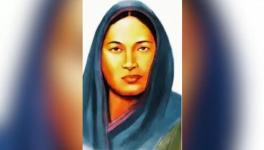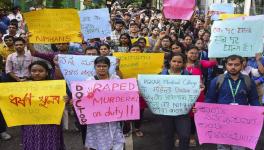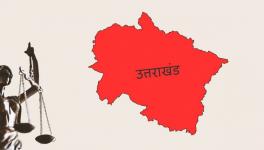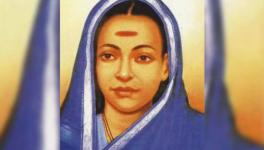Rameshwari Nehru: A Towering Feminist Figure of Late 19th Century India
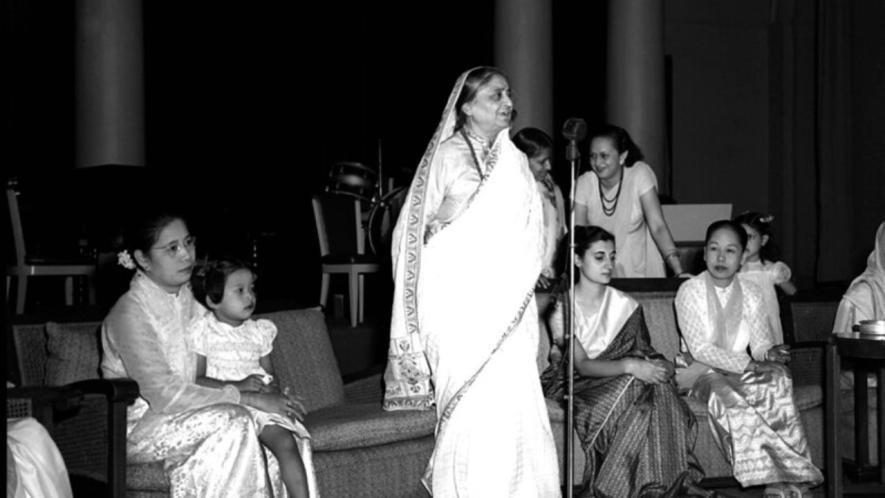
Photo taken at the reception at Delhi Gymkhana Club on October 23, 1951, held by the National Council of Women in India and various other womenâs Organizations in Delhi, in honour of the wife of the Burmese Prime Minister, Madame Nu, shows Shrimati Rameshwari Nehru welcoming the distinghished guest (left with the child) on behalf of the women of Delhi. Image Courtesy: Flickr
From her father’s patriarchal and conservative admonition that “a woman must be a good cook and should never let the bread burn on the tawa”, who was a victim of the purdah custom, to becoming an internationalist and a rationalist. Rameshwari Nehru was a towering feminist figure of the late 19th century and founded the Prayag Mahila Samiti in Allahabad and its mouthpiece which became India’s first Hindi vernacular women’s monthly journal Stree Darpan in 1909. The journal was discontinued in June 1928 and saw its revival in 2022.
Nehru amplified women’s voices in a deeply patriarchal society. Despite never having formal schooling, she nurtured her intellect through rationality and unyielding determination for the cause of liberation. Her work extended beyond borders, earning her laurels like the Padma Bhushan in 1955 and the Lenin Peace Prize in 1961 for her contributions as a social reformer. She stands tall as an enduring symbol leaving an indelible mark on the feminist history of India as a transformative power of courage and intellect.
Rameshwari Nehru was the President of the Delhi Women’s Conference in 1926, the only Indian woman in the government of India—Age of Consent Committee in 1928, the President of Children Aid in 1940, and the President of the All-India Women’s Conference in 1940.
As an internationalist, she was elected the Chairman of Committee of the Women’s Committee of the Commonwealth of India League, she represented India in international fora, such as the League of Nations in 1924, the World Women’s Congress in Copenhagen and the Afro-Asian Women’s Conference in Cairo in 1961 in the podium.
Indian history bears stark testimony to the epistemic injustice that has long fuelled prejudice and discrimination against women, a reality that persists even in post-colonial India. A century ago, when society had been deeply ingrained in inequalities Stree Darpan was a bold departure from the conservative societal norms, giving a counter-narrative for social transformation.
To provide context to how deeply patriarchy was entrenched in the society, the only Indian woman in the Age of Consent Committee was named Mrs Brij Lal Nehru (husband of Rameshwari Nehru). Rameshwari Nehru had taken the pen to disrupt centuries of systematic injustice. The call for reforms through the journal was an audacious act in an era when the colonial regime viewed free speech as a threat. As M.D. Chalmers infamously said while reinstating sedition laws in 1897, “Language may be tolerated in England, which it is unsafe to tolerate in India” likening free expression in the colony to smoking a cigar near a gunpowder room.
The fight for women’s emancipation was so radical in its time that even Motilal Nehru, father-in-law of Rameshwari Nehru, once cautioned about the articles in Stree Darpan, saying, “Just make sure you are not inviting any police search at Anand Bhawan.”
The women's movement was seen as an oddity to the patriarchal status quo. The movement for equality was seen as a “mental illness” afflicting the West and India is immune to such notions because “Indian women are traditionally under their parent’s control and docile” republished in Stree Darpan from Arya Prabha – September 1910.
Rameshwari Nehru stood steadfastly for equal rights of women in inheritance and equal standing in marriage laws with equal rights to work. She criticised the unequal practice of Hindu marriage which was upheld as a sacramental vow but only for women. She said marriage has lost its sanctity as it “binds women and leaves men absolutely free”. The plight of widows, especially young widows, who are condemned to lifelong widowhood enforced by society was “no less than slavery”.
As a solution, she observed monogamous marriages as the ideal for society and strongly advocated for legal provisions ensuring maintenance for divorced women. In her sharp critique of societal hypocrisy, she wrote “We judge the right and wrong of actions not according to the merits of the case but according to the sex of the agent.”
Rameshwari Nehru’s relentless advocacy for women’s rights shaped pivotal legal reforms, challenging entrenched gender biases across decades. She critiqued the Government of India Act of 1935, for limiting the franchise to married women. Her influence extended to Section 6 of the Hindu Minority and Guardianship Act of 1956, which recognised mothers as natural guardians in case of separation, to the Hindu Succession Amendment Act, of 2005, which after the dawn of the 21st Century finally gave coparcenary rights to the daughters by birth. Her vision for social justice for women was instrumental, she ardently supported the Hindu Code Bill, in her words “While our laws are rigid, social conditions are putrid. It is to save these victims of social tyranny that the law is sought to be changed”.
The Child Marriage Restraint Act of 1929 bore the legacy of Rameshwari Nehru’s vision. She had fearlessly taken to task the conservative pandits and mullahs for their irrationality in propagating child marriage since nothing can be traced either in the Vedic scriptures or the Quran which propagated child marriage.
Rameshwari Nehru believed that some form of injustice prevailed in every society, but untouchability was the worst form of prejudice peculiar to India. Even gods were the victims since not all castes had the privilege to access gods equally. The temple entry campaign in Tamil Nadu in 1939 affirmed her belief that the only power to weed out the worst form of injustice was the will of the masses.
Rameshwari Nehru’s vision of Pan-Asian collaboration emphasised shared cultural and historical ties. Her activism towards peace, anti-trafficking, and disarmament was a leading initiative under the Indo-Soviet Cultural Society and All India Peace Council. She believed a strong Pan-Asia cooperation would be instrumental in combating the trafficking of women.
As the Chairman of the editorial board of ‘The Asia Africa Review’, she held a strong stance on disarmament and neutrality of India amid the rising tension post the Second World War. On the weapon of mass destruction, she wrote “This discovery has robbed humanity of all security of life, men and women belonging to all countries without distinction of national boundaries, colour or creed, are living in constant dread of annihilation not of life alone, but of all they value and hold dear.”
The idea of India would be incomplete without recognising the contributions of women who shaped its identity. Rameshwari Nehru, a Gandhian and Socialist, belonged to the generation that envisioned India through the lens of Swaraj (self-rule), which gave the Indian Constitution its indigenous identity. For her, Swaraj was more than political freedom, it was a moral and social commitment rooted in Ahimsa (non-violence), advocating dignity and justice, irrespective of the consequence without yielding to hatred, even towards the oppressors.
Her unwavering resolve embodied the essence of just resistance, leaving a legacy ingrained in the Constitution. She envisaged a Constitution where there was no difference between men and women. The manifestation of a society that would be premised on “liberty, fraternity and equality and the future constitution of such a society will be based on love, truth, beauty and wisdom.”
Rameshwari Nehru admired the USSR (Union of Soviet Socialist Republics) for its national planning and for granting women the greatest amount of share in the administration. Speaking to The Indian Express, she highlighted how India could draw inspiration from aspects of Soviet life, aligning with Lenin’s belief that “you cannot draw the masses into politics without drawing in the women.”
In her unique fervour, she declared “Swaraj cannot be attained by people whose other halves are stricken by paralysis …. The battle of Swaraj has to be fought and won by men and women alike”.
Rameshwari Nehru’s legacy as the foremother of the Indian Republic has a lesson for the future generations. Addressing the future generation, she wrote, “The work of preparing India for the new life is yours. Do all you can to make it a mighty united nation living a righteous life of amity and goodwill, at perfect peace with one another, an example of solidarity for others to follow.”
The writer is a legal practitioner based in Delhi. The views are personal.
Get the latest reports & analysis with people's perspective on Protests, movements & deep analytical videos, discussions of the current affairs in your Telegram app. Subscribe to NewsClick's Telegram channel & get Real-Time updates on stories, as they get published on our website.









